'When is the next flood?': Bangkok's canal communities fear they are living on borrowed time
BANGKOK: Blindside Prathun is like a miniature h2o world. A spiderweb of canals splays out through a rare green landscape of coconut and fruit trees, alongside paths that connect an enduring customs.
This place dates back to the late Ayutthaya flow, or more than 200 years. Its people have lived effectually the water for generations and their fortunes have ebbed on the tides of the meandering Chao Phraya.
Wisdom has been inherited from the generations by; how water moves, how it drains and how it sustains.
Now, as modernity creeps closer all around this patch of green, an outlier amidst the grayness of Bangkok's sprawl, its residents wonder if their quondam knowledge tin can still keep them rubber.
It is a challenge existence posed to many of the Thai capital's poorest communities, those living on the fringes - and often, around water. They are the near vulnerable. Bangkok has long faced the threat of flooding, but climatic change is threatening to amplify the risks.
Nawin Meebunjong grew upward here, exploring the intricate canals. "I've been here since I was little. I grew upwardly with the water, pond in the canal. I went to school by boat. I go to the market past gunkhole. Everything involves h2o," he said.
It was a moment of turmoil in his life that turned him from someone who took his home for granted, to ane of its most passionate protectors.
The slap-up floods of 2022 brought disruption and damage correct across Bangkok, and Bang Prathun, with its close proximity to the major river artery of the city, was difficult hit. At the same time, his mother was fighting a losing battle with cancer and had to exist evacuated from her domicile due to the confusion and fear at the time.
READ: 'Nosotros have upset the residue of nature', Thai environment government minister warns amid green recovery efforts from pandemic
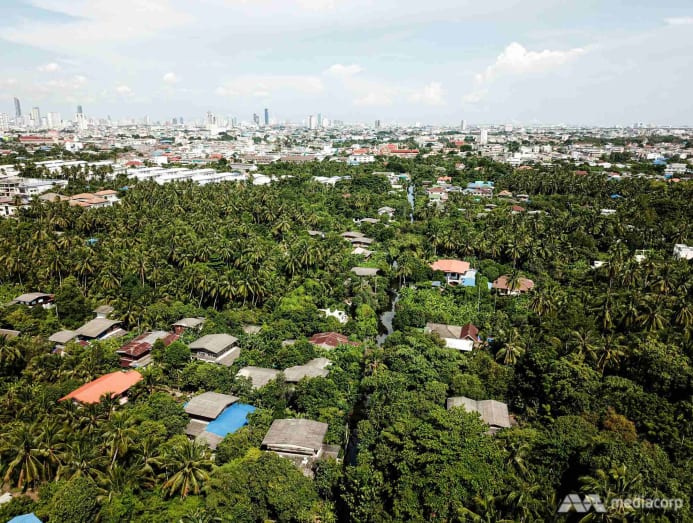
For Nawin, information technology was a painful standoff of momentous events. "The 2022 flood reversed the lives of many people, including me. Information technology fabricated me go interested in the canals and the things surrounding us," the 44-year-old said.
"After that, I changed my thinking from being a metropolis function man to a community-concerned person. Why did I never take care of the things I had? If these things were gone one twenty-four hour period, what would I exercise?
"Similar my mother. I did not have fourth dimension to have care of her. I only made money and worked. Finally, when she passed abroad, it was besides late to wait after her. Like the canal. This is why I became interested in the canal. It's also a female parent, the mother of the h2o. The mother that we should look afterwards," he said.
Nawin became the founder of the Rak Blindside Prathun group, which works inside the community to educate local people and help preserve the environment.
Residents have focused their efforts on maintaining traditional houses designed to withstand flooding, shaping drainage ditches to control the movement of water and retaining it through greenery and gardens.
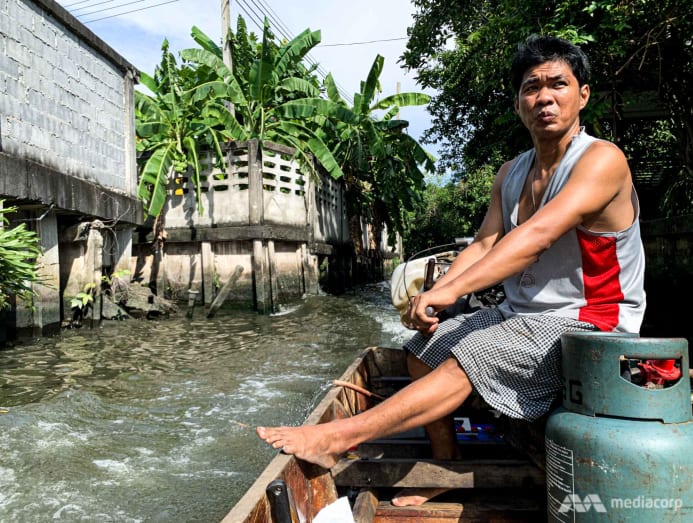
Simple ingenuity is congenital into the fabric of the community. It is a deliberate relationship synchronised with the water, rather than in disharmonize with a powerful element.
"We don't create brand-new wisdom. We only advance the ancient i to survive the flood. Living with it and bending to it," Nawin said.
"To live with it is to exist harmonised. So nosotros tin can live with nature. This is the approach to living with water. Nothing can conquer nature. Regardless of the approach we have, information technology's only an act of deferring, delay or control. But eventually, you can't win."
Whether Blindside Prathun can withstand future challenges is a question Nawin and his neighbours cannot reply. In many ways, their fate will be in the easily of others.
"Information technology HAS LIFE"
Canals are critical infrastructure for Bangkok. There are 1,161 in the city, including nine major ones. They act to drain extraordinary masses of water flowing from the due north of the state into the Gulf of Thailand.
They course role of Bangkok'southward polder flood defence system, which also includes tunnels, pump stations and retention ponds, known as "monkey cheeks". Dykes around the city assistance redirect water away from the metropolis, which is itself a natural floodplain, towards the bounding main.
Bangkok is located on depression ground, land where floodwaters should naturally menstruation just in mod times has been built upward to hold more than than ten million inhabitants and major industries.
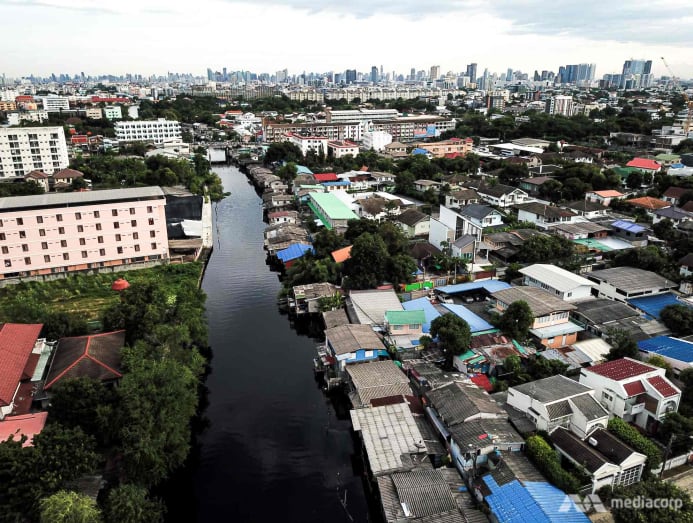
"I used to see how the city grew over 50 years and you can see this large patch of concrete creeping out over the wetlands that used to be a aqueduct for the river and how we drain our h2o from the north to the bounding main," said landscape architect Kotchakorn Voraakhom.
"From the outset, we built the city in the wrong identify just we cannot return. So now it's about finding the correct solution and irresolute the attitudes of the people and irresolute natural disasters to be role of their living," she said.
The city's drainage system is ageing and underdeveloped. And climate change is already adding more stress to its capacity, at the same time as citywide subsidence raises the prospects of seawater intrusion.
"Variations in the weather patterns pb to changes in rain. Pelting becomes more than severe and sometimes it rains outside its season. As a result, the existing drainage system is unable to behave the situation," said Vishnu Charoen, the director of the Technical and Planning Partitioning, at the Section of Drainage and Sewerage, part of the Bangkok Metropolitan Administration (BMA).
In innercity areas, localised flooding causes regular disruptions to people's daily lives. It is a symptom of growing density in the urban environs. More people are living in the city, turning empty spaces into crowded ones.
Rapid development has pushed the city's poor towards congested and increasingly undesirable retreats. Over time, those informal settlements came to be forth the canals.
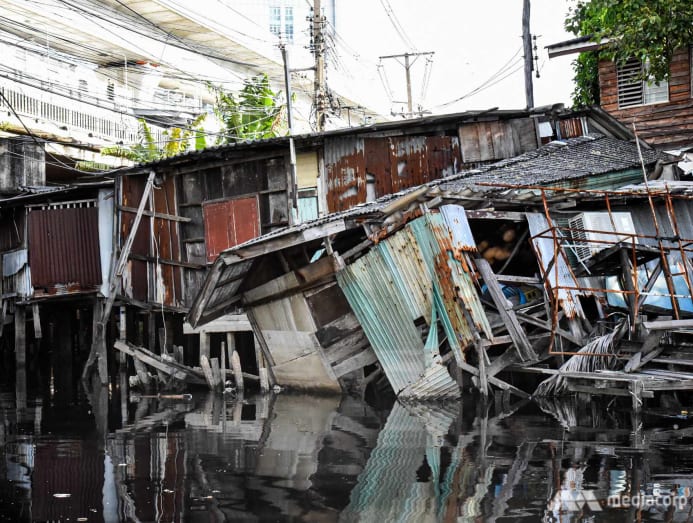
READ: Farthermost alluvion risk - New written report outlines potentially disastrous scenario for Ho Chi Minh City
With a rise of pollution and neglect, many of the waterways meant to facilitate the period of water have really done the opposite.
"People built houses encroaching on the canals, narrowing the canals and consequently reducing the effectiveness of the canals to drain water. When there is a inundation, this grouping of people volition be the first who face the flooding problem," Vishnu told CNA.
The Lat Phrao canal is 1 of the chief strategic channels in central Bangkok. Information technology has been an expanse riddled with problems of state encroachment and rubbish accumulation and characterised by the thick black and fetid h2o lapping at the stilts of wooden houses creeping over the culvert.
"There are 7,000 houses along the Lat Phrao culvert and 3,800 of them encroach on the canal. These houses, instead of helping water drainage, are obstacles," said Thanat Narupornpong, assistant director of the Community Organizations Development Institute (CODI), a government agency.
To defend the city from future flooding, the government has a variety of policies aimed to make the canals more effective. Fundamental to that is widening them by an average of x metres and edifice overflowing defences, forcing many houses to be removed and their occupants relocated.
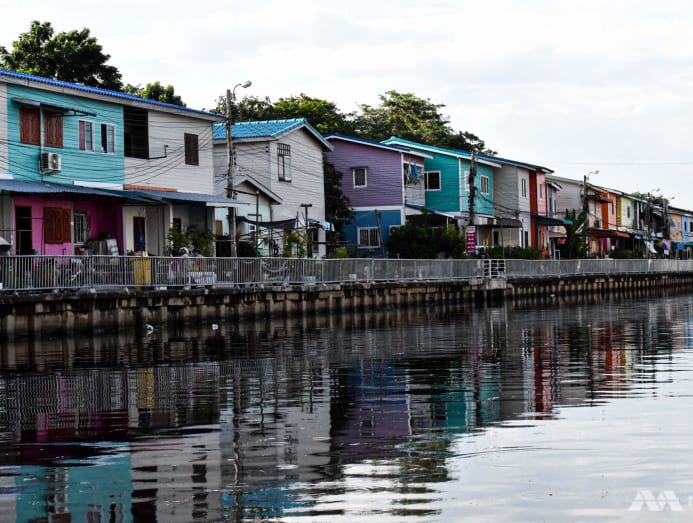
That has caused a natural and inevitable conflict with many of those who call the canals habitation.
"All houses along and in the canals are all illegal considering they are on land possessed by the Treasury Section. They did not go permission for structure," Thanat said.
CODI is making headway in a major resettlement and rehousing project at Lat Paro, which aims to consolidate all houses into safer, more modernistic dwellings further from the water, but generally in close proximity to the canal.
"The challenge for the project is that some of them said they didn't want to change their lifestyle. Non everyone agrees to move out," Thanat said.
Titapol Noijad was born in Wang Hin, one of dozens of communities that exist along Lat Phrao canal. He reminisces about the closeness of ties between neighbours, when growing rice and fishing in the flowing waters were nevertheless a daily reality in the area.
"In the past, the culvert was the middle of people's lives," he said. "The community used to be nice for people to stay. It had a sense of community and a subconscious loveliness.
"When I was child, I had a cute view here. But today I have to get out the community and go to a rural area to enjoy such beauty."
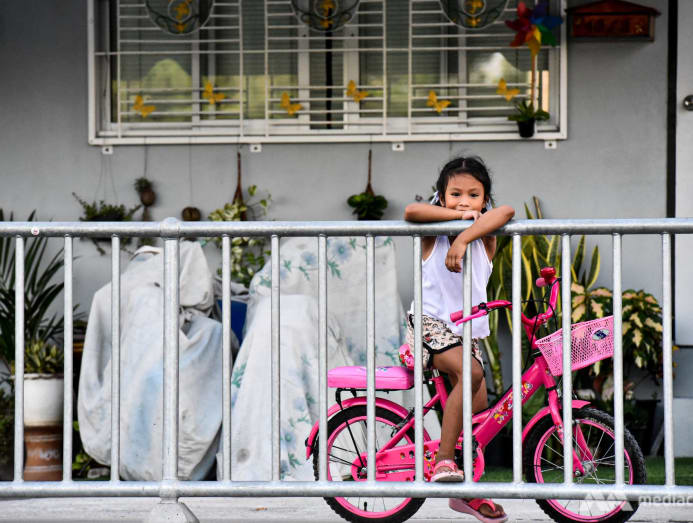
READ: The fight to save Bangkok from sinking into watery depths
Life has inverse forever here, as social connections fade and the worries about flooding - from the perspective of government and residents alike - become more prescient yr on twelvemonth.
Government agencies are working quickly to unclog the waterway, and many residents are happy with being relocated to new houses. Work is ongoing to install flood defences simply the results remain piecemeal.
Titapol notwithstanding holds onto promise that life on the canal will one solar day be every bit vibrant equally it once was.
People intendance almost each other, he said, and they are ready to adapt in order to stay. As a community leader, he has invested in empowering locals to manage waste product, share education campaigns and perform Buddhist rituals as a spiritual reminder of the water'southward influence.
"If there was merely the canal, but no life, I retrieve I would experience dejected. What we are trying to do is to make the canal alive," he said.
"Information technology has life. The culvert does non speak, merely the people living there do."

COMMUNITY AWARENESS
Involving canal communities in developing greater strategies for decision-making the alluvion is crucial, co-ordinate to urban compages and planning expert, Asst Prof Wijitbusaba Marome from the Urban Futures and Policy Lab at Thammasat University,
There are complex forces at play, she says, from housing affordability and admission, to communal understanding about what lies ahead. Their old noesis and ability to adapt is of import too - it should not be ignored, she says.
"In the terminate, downwardly at the local level, it's nearly social credence and whether the customs has awareness. Social acceptance requires time to communicate and portray how climate modify will link to their everyday lives. And then it's an emergency," she said.
"We don't really have holistic knowledge yet well-nigh how people tin suit and whether how they suit can be enough to cope with futurity changes.
"These low-income communities have faced flooding before so the question would exist how future floods will be. We are besides dealing with communities that have never faced flooding before. The question for them is, when is the next flood? There are no mechanisms to help them or talk to them about this," she added.
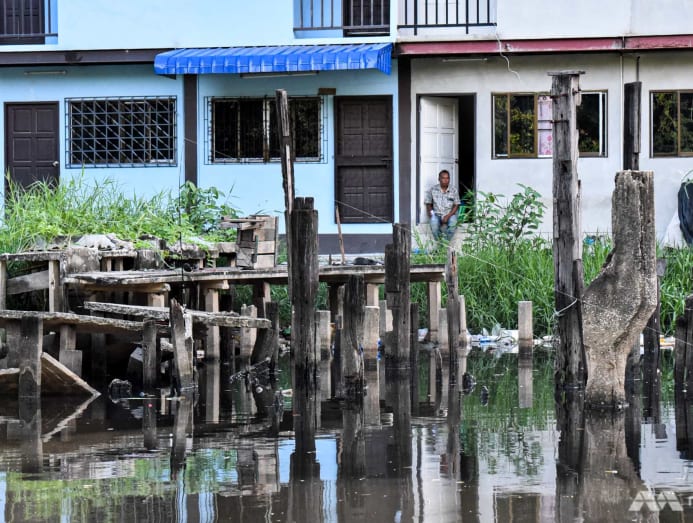
Wijitbusaba also believes the government needs to produce a ameliorate "heart level" masterplan to link broad flood policies with local-level interventions.
"I don't think Bangkok is resilient yet. We are very proficient at mitigating floods. We accept big policies to drain water from the lower Chao Phraya bowl. Nosotros accept a lot of construction policies. But resiliency is local," she said.
"The government's plans are not 100 per cent taking seriously the impacts of time to come climate change."
The BMA admits there are budget restraints and plans must be prioritised. Only Vishnu cites success in managing flood risks over the by one-half decade.
"The problem nosotros currently focus on is the water awaiting for drainage in Bangkok: how to drain the water to Chao Phraya River at the fastest pace," he said.
"Our goal is more rapid drainage every year. The evident figure is the number of flood gamble areas. We decreased the number of flood risk areas from 22 areas in 2022 to fourteen areas in 2020."
The current Bangkok main plan is beingness used until 2023, from when a new strategy that better accounts for climatic change is expected to be adopted. Mitigation remains the goal for the city, and if that fails, "we have to adapt to live with flood conditions", Vishnu says.
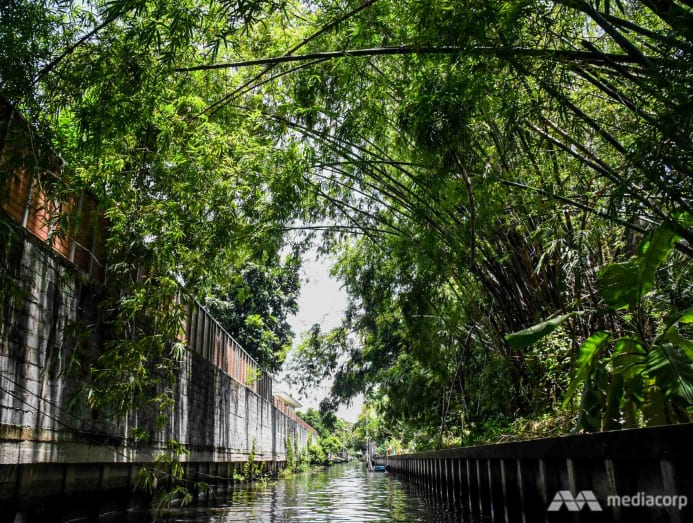
It is a plan that faintly echoes the long-held beliefs of the people of Bang Prathun.
"If we live in the way we used to, I will not be worried because I believe we have wisdom for living with h2o," Nawin said.
"If it changes, I will be worried because it's beyond the wisdom that we have. Nosotros might demand to invent some other wisdom or advance it in gild to fight with h2o.
"If one day the situation goes beyond our capacity, nosotros only escape. If nosotros can't coexist, we have to escape."
Boosted reporting past Thanit Nilayodhin.
Source: https://cnalifestyle.channelnewsasia.com/asia/flood-bangkok-canal-communities-climate-change-245471
Post a Comment for "'When is the next flood?': Bangkok's canal communities fear they are living on borrowed time"